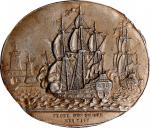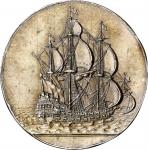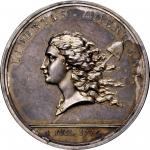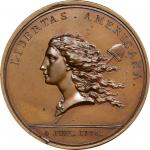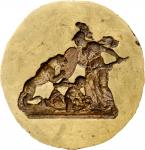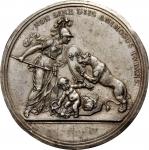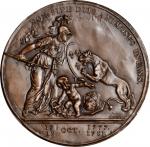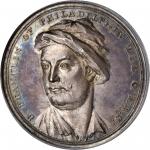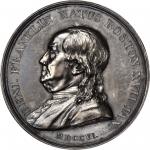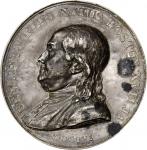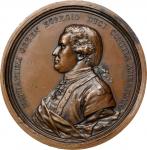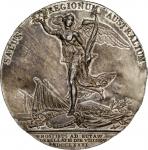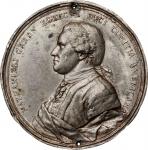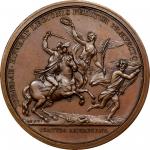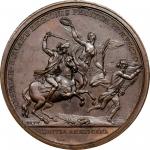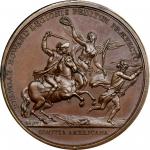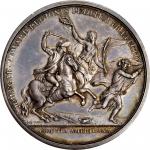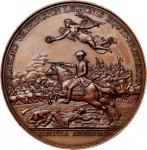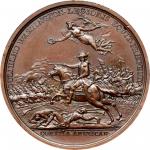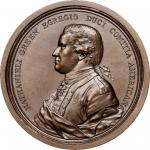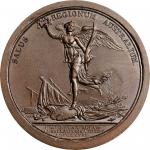1781 (after 1842) cast copy of a Nathanael Greene at Eutaw Springs electrotype. As Betts-597. Cast in copper or copper over lead. Unknown maker. 59.4 mm, 2486.4 grains. 6.3 - 6.8 mm thick. Choice About Uncirculated, nearly as made.Plain filed edge. A beautiful piece with a rich dark mahogany patina, exceptionally well made for what it is. On the other hand, easily the silliest piece in this collection and a testimony to the mania of Comitia Americana medal enthusiasts: this is a fake of a fake, a copy of a copy, a replica of a replica made desirable because the originals are so very rare. The craftsmanship of this piece is astoundingly good, but the manner in which it was made is still discernible by the fine granularity of the surface and scattered raised artifacts, two aspects that indicate casting. While the fine details are not perfectly crisp, they are still shockingly good for a cast. This undoubtedly has a great deal of age and we feel very secure estimating that this was produced in the third quarter of the 19th century. Any time after 1886, the producer or owner of this piece would have likely rather had one of the very pretty copies struck from new dies at the Philadelphia Mint.<p><strong>The Battle of Eutaw Springs</strong><p><strong>The Action:</strong><p>After Guilford Court House turned into a draw that was too costly for Cornwallis to do anything but regroup far to the east, Nathanael Greene turned south. Washingtons most trusted former deputy continued his plan to harass and divide the British forces that remained in South Carolina, by picking his spots and ensuring that resupply and communication lines with British-held Charleston were difficult to maintain. He met British commander Lord Rawdon back in Camden, where a young ruffian named Andrew Jackson was being held prisoner. Greene suffered a mild defeat at the indecisive Battle of Hobkirks Hill in April 1780. Rawdon evacuated Camden soon thereafter, knowing he was surrounded by American Continentals and local militia on all sides. Greene turned inland, meeting a newly reinforced force under Rawdon at Ninety-Six on the Carolina frontier in June 1780. The summer passed quietly. Rawdon returned to Charleston, then left for England - and was captured by deGrasse at sea. Lt. Col. James Stewart was left in charge of the British military presence in South Carolina. Nathanael Greene regained strength, attracted reinforcements, and waited.<p>His moment to strike came during the dog days of late August. Francis Marion, the legendary Swamp Fox, found his way to Greenes position, meeting forces under Lt. Col. Light-Horse Harry Lee (a Comitia Americana medal recipient for Paulus Hook), militia under General Andrew Pickens, and the seasoned troops commanded by Comitia Americana medal recipients Lt. Col. John Eager Howard and Lt. Col. William Washington. Greene took more than 2,000 men onto the field at Eutaw Springs, most of them well experienced and ready to fight.<p>Stewarts regulars and loyalists were almost as numerous as Greenes forces when they first encountered each other on the morning of September 8. Loyalist Capt. John Coffin, a Boston native (whose brother Sir Isaac Coffin was responsible for the [1827] Tristram Coffin medal cataloged as Betts-533), was the first to find the Patriot forces, while out on the morning forage. By 9 AM, battle lines had formed. Before long, both sides were disorganized and scattered. William Washington had fallen prisoner into British hands. By the time the smoke cleared, Greene had taken more than 500 British prisoners as well. Both sides held portions of the field when the skies opened with rain, and both had lost dozens of dead and a couple hundred wounded. Stewart withdrew to a position closer to the coast. Greene controlled the interior. <p>The battle had been something of a draw, but Greenes strategy had won. He had kept Cornwallis Southern force divided and occupied British attention in the Carolinas. He kept his army together, and he controlled most of inland South Carolina. As Greene played cat and mouse in the Southern Department, Cornwallis marched to his doom in Virginia. He arrived in Yorktown on August 1, a month before Eutaw Springs. When Greenes army left the field on September 8, the French Navy had taken control of the Chesapeake, sailed up the James River, and essentially sealed Cornwallis fate. Within a week, Washington and Lafayette arrived on Virginias Middle Peninsula. The game was up. Greene had played his part flawlessly, and helped assure American victory. Congress voted him a gold medal barely a week after Cornwallis laid down his arms for the last time.<p><strong>The Resolution:</strong><p><em>Resolved, That the thanks of the United States in Congress assembled, be presented to Major General Greene, for his wise, decisive and magnanimous conduct in the action of the 8th of September last, near the Eutaw Springs, in South Carolina; in which, with a force inferior in number to that of the enemy, he obtained a most signal victory over the British army commanded by Colonel Stewart:</em><p><em>That the thanks of the United States in Congress assembled, be presented to the officers and men of the Maryland and Virginia brigades, and Delaware battalion of continental troops, for the unparalleled bravery and heroism by them displayed, in advancing to the enemy through an incessant fire, and charging them with an impetuosity and ardor that could not be resisted:</em><p><em>That the thanks of the United States in Congress assembled, be presented to the officers and men of the legionary corps and artillery, for their intrepid and gallant exertions during the action:</em><p><em>That the thanks of the United States in Congress assembled, be presented to the brigade of North Carolina, for their resolution and perseverance in attacking the enemy, and sustaining a superior fire:</em><p><em>That the thanks of the United States in Congress assembled, be presented to the officers and men of the state corps of South Carolina, for the zeal, activity and firmness by them exhibited throughout the engagement:</em><p><em>That the thanks of the United States in Congress assembled, be presented to the officers and men of the militia, who formed the front line in the order of battle, and sustained their post with honor, propriety and a resolution worthy of men determined to be free.</em><p><em>Resolved, That two pieces of field Ordnance be presented to Major General Greene by the Commander in Chief, with a motte engraved "from the United States in Congress Assembled to Major Genl. Greene, in honour of the Victory obtained under his Command near the Eutaw Springs in So Carolina on the 8th. September A. D. 1781.</em><p><em>Resolved, That a Sword be presented to Colo Williams of the Maryland line for his great military skill and uncommon exertions on this occasion.</em><p><em>Resolved, That a British standard be presented to Major General Greene, as an honorable testimony of his merit, and a golden medal emblematical of the battle and victory aforesaid:</em><p><em>That Major General Greene be desired to present the thanks of Congress, to Captains Pierce and Pendleton, Major Hyrne and Captain Shubrick, his aids de camp, in testimony of their particular activity and good conduct during the whole of the action:</em><p><em>That a sword be presented to Captain Pierce, who bore the generals despatches, giving an account of the victory, and that the Board of War take order herein.</em><p><em>Resolved, That the thanks of the United States in Congress assembled, be presented to Brigadier General Marion, of the South Carolina militia, and the officers and men under his Com for his wise, gallant and decided conduct, in defending the liberties of his country; and particularly for his prudent and intrepid attack on a body of the British troops, on the 30th day of August last; and for the distinguished part he took in the battle of the 8th of September.</em><p><em>- Continental Congress Resolution of October 29, 1781</em><p><em></em><strong>The Acquisition:</strong><p>Even though Greenes heroic actions at Eutaw Springs were the latest to earn the honor of a Congressional medal, his medal was the second one delivered, following only the one Franklin finished so quickly for De Fleury and Stony Point. Franklin finished only that first effort; David Humphreys bested him by one, seeing only this medal and the one for Horatio Gates through to completion.<p>It was a coup that Humphreys was able to hire the uber-talented Augustin Dupre to accomplish Greenes medal. It would be the first of three Comitia Americana medals Dupre would engrave, followed by the medals for Morgan and Jones, though Dupre would gain lasting American fame for his Libertas Americana medal. <p>On November 19, 1785, Humphreys and Dupre signed a contract for the completion of the Nathanael Greene medal, requiring Dupre to produce an obverse depicting a portrait of General Greene and a reverse with "Victory treading under her feet broken arms, with the legend and the exergue," strike 24 medals exactly, and deliver the dies and medals to Humphreys upon their completion. John Adams, holding the Congress European pursestrings in Paris, wrote home to John Jay to report "Humphreys brought with him, an order upon Mr Grand for Money to pay for a Medal to be Struck for each of the Generals Washington, Gates and Green … As We Supposed it to be the Undoubted Intention of Congress that these Small Presents should be made in honour of those great Events and immortal Actions, I consented to draw for the Money upon the Same Bankers to the Amount of about a Thousand Pounds. this also I hope will meet the Approbation of Congress."<p>Dupre ran into a few snags along the way. He asked Humphreys to get him a new likeness of Greene after the painted miniature wasnt working as proper inspiration for an engraved profile portrait. Humphreys passed the request along to Secretary of War Henry Knox in May 1786. The lengthy delay Humphreys tolerated from Dupre was apparently one of the principal reasons it fell to Duvivier, not Dupre, to accomplish General Washingtons medal, the first authorized and ostensibly most important Comitia Americana medal of them all.<p>A year passed, during which Humphreys left Paris. Thomas Jefferson took over, and on February 14, 1787, he wrote to John Jay that he was in receipt of Greenes gold medal, 23 examples in bronze, and the dies, which he reported he had "sealed up" and "shall retain till I am honored with [Congresss] orders." A month later, Jeffersons secretary William Short packed up the lot and sent them home, with an update for John Jay:<p><em>Agreeably to Mr.: Jeffersons directions on his leaving Paris, I have the honor of forwarding to Your Excellency, the medal engraved for Genl. Greene, under the resolution of Congress. There is one of gold and twenty three of bronze, all of which are committed to the care of Mr. Walton of New York, who sails in the French Packet the 25th. of this month. The medal for Genl. Gates ordered by Congress and contracted for by Colo. Humphries is not yet finished; but will certainly be in time to be sent by the May Packet.</em><p>Alas, Greene had passed to his reward on June 19, 1786. <p>The Presentation:<p>Like John Stewart, Nathanael Greenes passing before his medal was completed required Congress to find a next of kin to whom his medal could be presented. The gold medal and its dies arrived in the United States and were delivered into the hands of Arthur St. Clair, the President of Congress on July 6, 1787. On August 9, St. Clair sent the gold medal to Jeremiah Wadsworth, the famous Connecticut financier and patriot who served as Greenes executor. <p>St. Clairs letter was sold as lot 378 in Stan V. Henkels April 1891 sale of Washington Relics consigned by Lawrence Washington, Bushrod Washington, and Thomas B. Washington, though how the letter came to be in their possession is unclear. The catalog excerpts the letter as follows:<p><em>It is much to be regretted, and l do most sincerely regret, that General Greene did not survive to receive this further testimony of the sense his country had of his services, particularly of the gallant action at the Eutaw. The memory of it, however, will be thereby long preserved, and it cannot fail to be very acceptable to his family. And when the story is related to his children, and the design of the medal explained to them, as it will be, whilst their veneration for their father is increased, a sense of gratitude and affection for their country, thus careful to accord his Glory, must be raised in their tender minds, and the generous resolution instantly formed to step forward in its service in the same honorable faith, should it ever be necessary, with the honest hope of meriting like rewards.</em><p>The paper trail goes silent after that, though most sources agree that Wadsworth passed the medal along to Kitty Greene, the generals fetching young widow, then just 32 years old. Julian appears to be the only source for the claim that Wadsworth also presented Ms. Greene the original dies. Whether she received the dies or not, they have not been seen since. Greenes gold medal survives, the property of the state of Rhode Island, on deposit at the Rhode Island Historical Society.<p><strong>The Nathanael Greene at Eutaw Springs Medal:</strong><p><strong>Obverse: </strong>A portrait of Greene in profile facing left, wearing his military uniform but also draped (a symbol of his recent passing?), surrounded by the legend NATHANIELI GREEN EGREGIO DUCI COMITIA AMERICANA or "To Nathanael Greene, distinguished leader, from the American Congress." This is the only Comitia Americana medal to incorporate the words COMITIA AMERICANA into a non-exergual inscription.<p><strong>Reverse: </strong>In the words of the Humphreys-Dupre contract of 1785, "Victory treading under her feet broken arms," including flags, a fasces, a broken sword, a split shield, a helmet, and a broken arrow, along with an olive branch. Around the top periphery, SALUS REGIONUM AUSTRALIUM or "Safety in the Southern regions. In the exergue, HOSTIBUS AD EUTAW DEBELLATIS DIE VIII SEPT MDCCLXXXI, meaning "The enemy utterly defeated at Eutaw, September 8, 1781." The signature DUPRE is hidden above the left side of the exergual line.<p>From the John W. Adams Collection. Acquired from Joe Levine of Presidential Coin and Antique, August 2004. Earlier, from NASCA’s sale of the Kessler-Spangenberger Collection, April 1981, lot 1656 (at $110).


